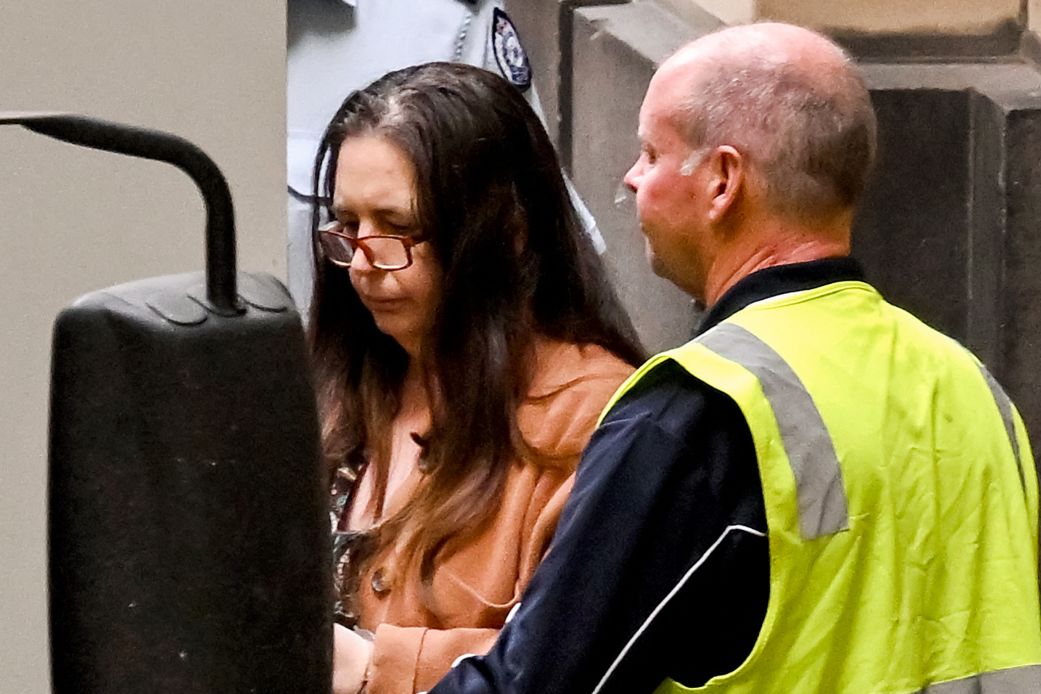The chilling case of an Australian woman sentenced to life for killing three people with toxic mushrooms has shocked communities across Australia and beyond. This story has not only gripped the nation with its dark twists but also reignited debates about food safety, trust in domestic gatherings, and the thin line between hospitality and horror. At the center of the tragedy is a seemingly ordinary family meal that turned into a deadly affair when mushroom poisoning claimed three innocent lives and left one more fighting for survival.
- The Deadly Lunch in Rural Victoria
- The Court Case and Sentencing
- The Science Behind Death Cap Mushrooms
- Public Reaction and Media Coverage
- The Ripple Effect on the Community
- Broader Conversations on Food Safety
- Expert Opinions on the Case
- The Human Element: Families Torn Apart
- Global Attention and Comparisons
- Lessons Learned from the Case
- FAQs
- What mushrooms were involved in the poisoning case?
- How many people died in the Australian mushroom poisoning case?
- What was the sentence given to the accused woman?
- Can cooking mushrooms reduce their toxicity?
- Why did this case attract so much attention?
- Conclusion
What makes this case especially unsettling is the ordinariness of the setting. A Sunday lunch, a homemade beef Wellington, and a group of family members gathered together should have been the scene of warmth and connection. Instead, it ended in betrayal, grief, and eventually, a criminal trial that exposed secrets and sparked widespread speculation. As the legal process concluded with a life sentence for the accused, Australians were left to reflect on trust, justice, and the devastating consequences of a single decision.
The Deadly Lunch in Rural Victoria
The events unfolded in the small town of Leongatha, Victoria, where the accused woman hosted a lunch at her home in July 2023. Among the guests were her former in-laws: Don and Gail Patterson, both in their seventies, and Gail’s sister Heather Wilkinson. Heather’s husband, Reverend Ian Wilkinson, also joined the gathering.
The meal featured a beef Wellington dish that allegedly contained death cap mushrooms, one of the world’s most toxic fungi. Within days, Don, Gail, and Heather had tragically lost their lives after suffering severe organ failure. Ian Wilkinson survived but endured a harrowing medical battle that included a liver transplant.
This seemingly ordinary family meal spiraled into a nightmare that gripped the nation. From the beginning, questions swirled: Was it an accident? Could the mushrooms have been foraged unknowingly? Or was this an intentional act of poisoning?
The Court Case and Sentencing
After months of investigation, the woman at the center of the case was charged with murder. The prosecution argued that she deliberately served the toxic mushrooms, fully aware of their lethal potential. Evidence presented in court included inconsistencies in her statements, her purchase of a food dehydrator later discarded at a local landfill, and her strained relationship with the victims.
The defense maintained that she had no intent to harm, claiming she had unknowingly used poisonous mushrooms in her cooking. However, the jury found the evidence of intentionality compelling. Her actions after the meal, particularly her delayed response in seeking medical help, raised further suspicion.
In 2025, the court delivered its verdict: life imprisonment. The judge emphasized the premeditated nature of the crime, the breach of trust involved, and the profound loss inflicted on families and communities.
The Science Behind Death Cap Mushrooms
The case brought widespread public attention to death cap mushrooms (Amanita phalloides), which are responsible for more than 90% of mushroom-related fatalities worldwide. Just one mushroom can kill an adult, and cooking does not neutralize its toxins.
Symptoms of poisoning typically appear within six to twelve hours and include nausea, vomiting, diarrhea, and severe dehydration. The toxins then attack the liver and kidneys, often leading to organ failure. Without immediate medical intervention, survival is unlikely.
Experts warn that death cap mushrooms are deceptively similar in appearance to edible varieties, which increases the risk of accidental ingestion. In Australia, they are found particularly in Victoria and the Australian Capital Territory, where foraging is popular but potentially deadly.
Public Reaction and Media Coverage
The case sparked intense media coverage in Australia, with newspapers, television broadcasts, and social media filled with speculation and updates. The story had all the elements of a gripping crime drama: a family feud, an innocent meal, and hidden tensions.
Public opinion was deeply divided. Some saw the accused as a calculated murderer who betrayed the sacred act of sharing food. Others believed she was the victim of tragic circumstance, guilty only of ignorance. The extensive coverage also led to a surge in public awareness about mushroom foraging dangers, with authorities issuing repeated warnings to avoid wild mushrooms altogether.
The Ripple Effect on the Community
Leongatha, once known as a quiet rural town, became synonymous with the “toxic mushroom case.” The tragedy left scars not only on the families of the victims but also on the broader community. Locals spoke of the unease that followed, with neighbors questioning how such a crime could unfold in their midst.
Community leaders organized memorials for the victims, and churches across Victoria held services honoring Don, Gail, and Heather. Reverend Ian Wilkinson, the sole survivor, became a symbol of resilience, though he also carried the emotional weight of losing his wife and close relatives in one devastating afternoon.
Broader Conversations on Food Safety
Beyond the sensational aspects of the case, the incident also reignited national discussions on food safety and the risks of mushroom foraging. The Australian health department issued fresh guidelines, warning the public against consuming any mushrooms found in the wild unless identified by experts.
Statistics show that mushroom-related poisonings are relatively rare but disproportionately deadly. In Australia, several cases are reported each year, but the death cap mushroom remains the primary culprit. Medical experts urged hospitals to be better equipped for rapid diagnosis and treatment, including access to specialized liver care.
Expert Opinions on the Case
Criminologists and legal scholars have weighed in on the significance of the case. Professor Karen Green from Monash University described it as “a disturbing example of how ordinary social rituals, such as sharing a meal, can be weaponized in the most shocking way.”
Forensic experts also highlighted the importance of meticulous investigation. Dr. Michael Tan, a toxicology specialist, explained: “This case underscores how difficult it can be to determine intent in poisoning cases. The science of toxins is precise, but human behavior is not. Establishing intent is always the ultimate challenge.”
The Human Element: Families Torn Apart
At the heart of this tragedy are the victims and their families. Don and Gail Patterson were remembered as pillars of their church and community, known for their kindness and generosity. Heather Wilkinson was described as warm and compassionate, deeply involved in volunteer work. Their loss left an irreplaceable void in the lives of those who loved them.
For the families, justice brings some closure, but it cannot erase the pain. The sentencing may ensure accountability, yet it cannot restore the lives lost or heal the fractures in relationships that once held families together.
Global Attention and Comparisons
The Australian mushroom poisoning case drew international attention, with global media outlets comparing it to other notorious poisoning cases worldwide. Poisoning, as a method of murder, has long fascinated the public because of its stealthy, intimate nature. Unlike more overt acts of violence, poisoning requires patience, knowledge, and often a betrayal of trust.
The case has been likened to infamous incidents in the UK, where poisoning cases have also made headlines, sparking questions about food safety and criminal intent. It serves as a reminder that crimes involving food and toxins touch on universal fears: the vulnerability of trusting what we consume.
Lessons Learned from the Case
This tragedy leaves behind critical lessons for society:
- Food Safety Education: Greater awareness of the dangers of wild mushrooms is essential to prevent accidental poisonings.
- Strengthened Legal Processes: Investigations into poisoning cases require specialized forensic and toxicology expertise.
- Community Vigilance: Trust is vital in communities, but so too is awareness that even familiar settings can hold risks.
- Support for Survivors: Individuals like Reverend Ian Wilkinson symbolize survival but also highlight the need for long-term psychological and medical support.
FAQs
What mushrooms were involved in the poisoning case?
The poisoning involved death cap mushrooms (Amanita phalloides), one of the most toxic mushrooms in the world.
How many people died in the Australian mushroom poisoning case?
Three people died after consuming a meal allegedly laced with death cap mushrooms, while one man survived following a liver transplant.
What was the sentence given to the accused woman?
The woman was sentenced to life imprisonment for intentionally poisoning her guests with toxic mushrooms.
Can cooking mushrooms reduce their toxicity?
No. Cooking or boiling does not reduce the toxicity of death cap mushrooms. The deadly compounds remain potent and can cause fatal organ failure.
Why did this case attract so much attention?
The case gained widespread attention because it combined family dynamics, betrayal, and a seemingly ordinary meal that turned deadly, sparking debates about trust and intent.
Conclusion
The sentencing of the Australian woman to life imprisonment for killing three people with toxic mushrooms will remain one of the most haunting criminal cases in the nation’s history. It is a case that shook communities, destroyed families, and forced Australians to reckon with both the fragility of trust and the dangers of toxic fungi.
More than a crime story, it is a human tragedy with lessons for food safety, law enforcement, and community resilience. While the legal system has delivered justice, the pain and loss endured by the victims’ families serve as a somber reminder of the irreversible consequences of one meal turned fatal.







